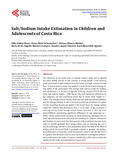Mostrar el registro sencillo del ítem
Salt/Sodium Intake Estimation in children and adolescents of Costa Rica
| dc.creator | Núñez Rivas, Hilda Patricia | |
| dc.creator | Holst Schumacher, Ileana | |
| dc.creator | Blanco Metzler, Adriana | |
| dc.creator | Montero Campos, María de los Ángeles | |
| dc.creator | Campos Saborío, Natalia | |
| dc.creator | Benavides Aguilar, Karla | |
| dc.date.accessioned | 2021-10-29T19:44:16Z | |
| dc.date.available | 2021-10-29T19:44:16Z | |
| dc.date.issued | 2020 | |
| dc.identifier.citation | https://www.scirp.org/journal/paperinformation.aspx?paperid=103612 | |
| dc.identifier.issn | 2157-9458 | |
| dc.identifier.uri | https://hdl.handle.net/10669/84867 | |
| dc.description.abstract | The objectives of this study were to estimate sodium intake and to identify the main dietary sources of this nutrient in young people. Cross-sectional study performed in 2685 students from 64 schools and high-schools of Costa Rica. A food frequency survey was applied to study the food and beverage intake habits of the participants. The average daily sodium intake for children and adolescents 7 to 18 years of age was 3214 mg. Around 97% of the students had sodium intakes > 2300 mg per day with significant differences by age subgroup, sex and nutritional status due to excess body weight (p < 0.001). The average sodium density of the diet was 1698 mg sodium/1000kcal, and the average addition of salt to the food was 445 mg of sodium (1.1 grams of salt). Including the amount added to the served food, the average sodium intake for children and adolescents from 7 to 18 years of age increased to 3434 mg and the overall average sodium density increased to 1821 mg of sodium/ 1000kcal, maintaining significant differences by age subgroups (p < 0.001). These results justify carrying out social marketing campaigns that include educational processes with sense and meaning for children, adolescents and families, in such a way that these groups of the population become motivated to modify gradually their eating habits, such as reducing the use of sauces, seasonings and salt in food preparation and at the table. If the habit of adding salt to the served food is gradually reduced or avoided, the children and adolescents in Costa Rica could decrease the intake of salt per day from 1 to 2 grams. This decrease could be even more effective if youngsters additionally would remove the intake of sauces, contributing in this way to achieve the maximum salt intake recommendation (5 g per day). | es_ES |
| dc.language.iso | eng | es_ES |
| dc.source | Food and Nutrition Sciences, vol.11(10), pp.919-941 | es_ES |
| dc.subject | Salt | es_ES |
| dc.subject | Sodium intake | es_ES |
| dc.subject | Children | es_ES |
| dc.subject | Adolescents | es_ES |
| dc.subject | Costa Rica | es_ES |
| dc.subject | NUTRICION - INVESTIGACIONES - COSTA RICA | es_ES |
| dc.subject | NIÑOS - NUTRICION - COSTA RICA | es_ES |
| dc.subject | HABITOS ALIMENTICIOS | es_ES |
| dc.title | Salt/Sodium Intake Estimation in children and adolescents of Costa Rica | es_ES |
| dc.type | artículo original | |
| dc.identifier.doi | 10.4236/fns.2020.1110065 | |
| dc.description.procedence | UCR::Vicerrectoría de Investigación::Unidades de Investigación::Ciencias de la Salud::Centro de Investigación en Hematología y Trastornos Afines (CIHATA) | es_ES |
Ficheros en el ítem
Este ítem aparece en la(s) siguiente(s) colección(ones)
-
Microbiología [1171]


